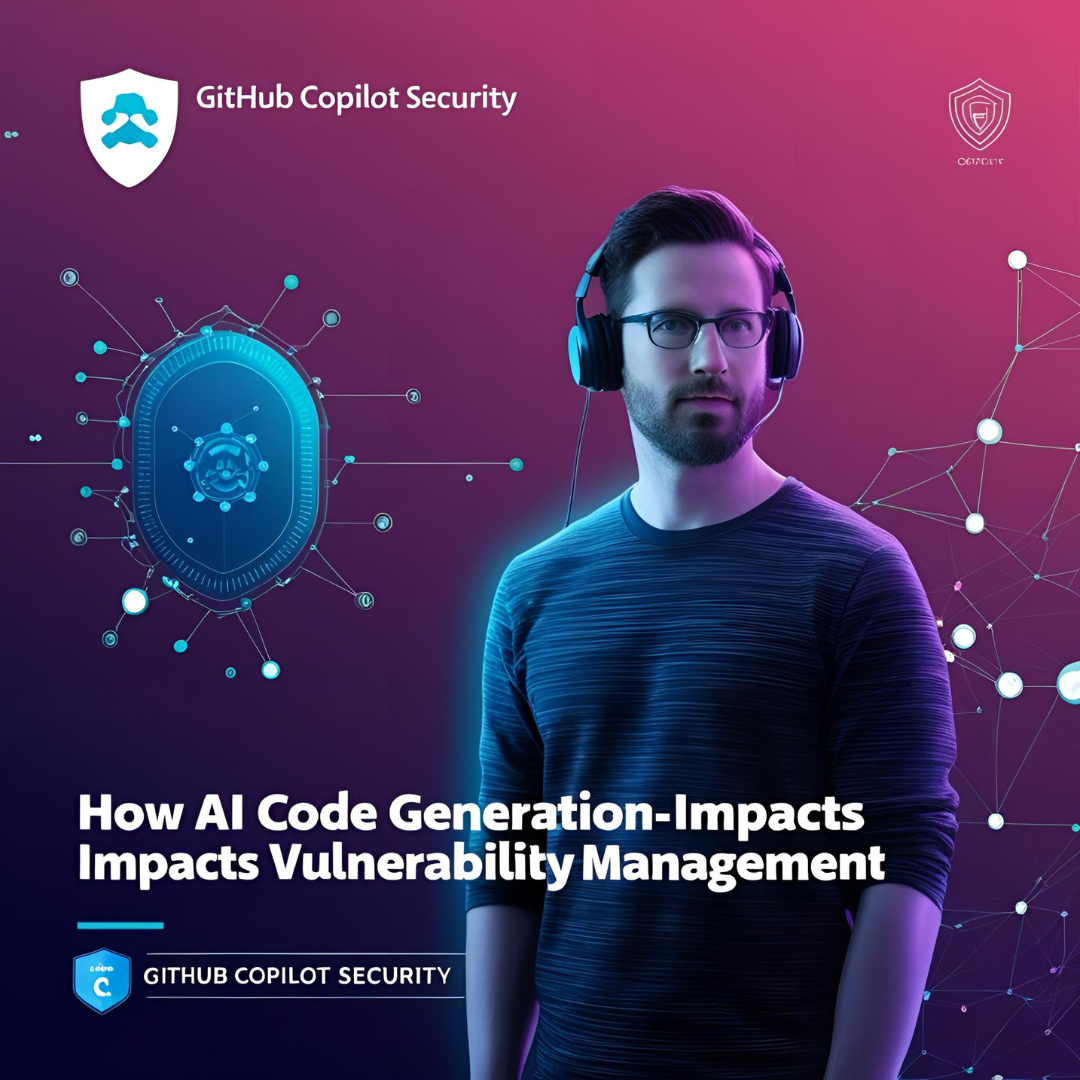As artificial intelligence continues to reshape software development, GitHub Copilot has emerged as one of the most widely adopted AI-powered coding assistants. While this technology offers unprecedented productivity gains, it also introduces new security considerations that development teams must address. Understanding how AI code generation impacts vulnerability management is crucial for maintaining secure software development practices in the AI era.
The Security Landscape of AI-Generated Code
GitHub Copilot generates code suggestions based on patterns learned from billions of lines of publicly available code. This approach, while powerful, creates unique security challenges that differ from traditional vulnerability management approaches.
Common Security Risks in AI-Generated Code
Inherited Vulnerabilities AI models can inadvertently reproduce security flaws present in their training data. Common issues include:
- SQL injection patterns
- Cross-site scripting (XSS) vulnerabilities
- Insecure cryptographic implementations
- Hard-coded secrets and credentials
- Buffer overflow conditions
Context Blindness Copilot generates code based on immediate context but may lack broader application security awareness:
- Missing input validation
- Inadequate error handling
- Improper authentication checks
- Insufficient authorization controls
Outdated Security Practices Training data may include deprecated or insecure coding patterns that were acceptable in the past but are now considered vulnerabilities.
Impact on Traditional Vulnerability Management
The integration of AI code generation tools fundamentally changes how organizations approach vulnerability management:
Shifted Responsibility Models
Traditional vulnerability management often relies on:
- Post-development security testing
- Periodic code reviews
- Automated scanning tools
- Penetration testing
With AI-generated code, responsibility shifts toward:
- Real-time code review during generation
- Enhanced developer security awareness
- Proactive prompt engineering
- Continuous monitoring of AI suggestions
Accelerated Development, Accelerated Risk
While Copilot increases development velocity, it can also accelerate the introduction of vulnerabilities if not properly managed. Teams must balance speed with security by implementing robust safeguards.
Best Practices for Secure AI Code Generation
1. Implement Multi-Layered Security Reviews
Human Oversight
- Never blindly accept AI-generated code
- Conduct thorough code reviews for all AI suggestions
- Train developers to recognize common vulnerability patterns
Automated Security Testing
- Integrate static application security testing (SAST) tools
- Implement dynamic application security testing (DAST)
- Use software composition analysis (SCA) for dependencies
2. Enhance Developer Security Training
AI-Specific Security Awareness
- Educate teams about AI-generated code risks
- Provide training on secure prompt engineering
- Establish guidelines for AI tool usage
Continuous Learning
- Regular security workshops
- Vulnerability case studies
- Hands-on secure coding exercises
3. Establish AI Code Generation Policies
Usage Guidelines
- Define when AI assistance is appropriate
- Specify review requirements for AI-generated code
- Establish approval processes for security-critical components
- Create documentation standards for AI-assisted development
Quality Gates
- Mandatory security reviews for AI-generated code
- Automated vulnerability scanning before deployment
- Performance and security benchmarking
4. Leverage Security-Focused Prompting
Secure Prompt Engineering
- Include security requirements in prompts
- Specify input validation needs
- Request error handling implementation
- Ask for security documentation
Example Secure Prompts
"Generate a user authentication function with proper input validation,
secure password hashing, and rate limiting protection"
"Create a database query function that prevents SQL injection and
includes proper error handling"
Tools and Technologies for Enhanced Security
Static Analysis Integration
IDE Plugins
- SonarLint for real-time vulnerability detection
- Checkmarx CxSAST integration
- Veracode Security Scanner
CI/CD Pipeline Security
- GitHub Advanced Security features
- GitLab Security Scanning
- Jenkins security plugins
AI-Powered Security Tools
Complementary AI Security Solutions
- CodeQL for semantic code analysis
- Snyk for dependency vulnerability scanning
- GitHub Dependabot for automated updates
Monitoring and Observability
Runtime Security Monitoring
- Application performance monitoring (APM)
- Security information and event management (SIEM)
- Runtime application self-protection (RASP)
Organizational Strategies for AI Security Governance
Security by Design with AI
Architecture Considerations
- Design security checkpoints in AI-assisted workflows
- Implement defense-in-depth strategies
- Plan for AI tool limitations and failures
Risk Assessment Framework
- Classify AI-generated code by risk level
- Define acceptance criteria for different risk categories
- Establish escalation procedures for high-risk code
Compliance and Regulatory Considerations
Industry Standards
- Align with OWASP guidelines
- Follow NIST Cybersecurity Framework
- Comply with relevant regulatory requirements
Documentation and Audit Trails
- Maintain records of AI-generated code
- Document security review processes
- Track vulnerability remediation efforts
Measuring Security Effectiveness
Key Performance Indicators (KPIs)
Vulnerability Metrics
- Time to vulnerability detection
- Mean time to remediation
- Vulnerability density in AI-generated vs. human-written code
- False positive rates in security scanning
Process Metrics
- Code review coverage
- Security training completion rates
- Policy compliance scores
- Developer security awareness levels
Continuous Improvement
Feedback Loops
- Regular security assessments
- Developer feedback collection
- AI tool performance evaluation
- Security process optimization
The Future of AI-Assisted Secure Development
Emerging Trends
Enhanced AI Security Models
- Security-trained language models
- Context-aware vulnerability detection
- Automated security fix suggestions
- Integrated threat modeling
Industry Evolution
- Standardized AI security frameworks
- Regulatory guidance development
- Enhanced tool interoperability
- Community-driven security patterns
Preparing for Tomorrow
Skill Development
- Cross-functional security expertise
- AI literacy for security teams
- Prompt engineering capabilities
- Hybrid human-AI collaboration skills
Technology Investment
- Next-generation security tools
- AI-powered vulnerability management platforms
- Integrated development environment enhancements
- Cloud-native security solutions
Conclusion
GitHub Copilot and similar AI code generation tools represent a paradigm shift in software development that requires equally transformative approaches to vulnerability management. Success in this new landscape demands a balanced strategy that harnesses AI’s productivity benefits while maintaining rigorous security standards.
Organizations must invest in enhanced developer training, implement robust security processes, and adopt tools that complement AI-generated code with comprehensive security analysis. The goal is not to eliminate AI assistance but to create a secure, sustainable framework for AI-augmented development.
As AI code generation continues to evolve, so too must our security practices. By proactively addressing these challenges today, development teams can build the foundation for secure, AI-assisted software development that scales with organizational needs while protecting against emerging threats.
The future of secure software development lies not in choosing between human expertise and AI assistance, but in creating synergistic approaches that leverage the strengths of both while mitigating their respective limitations. Organizations that master this balance will be best positioned to thrive in the AI-driven development landscape while maintaining the highest security standards.


Leave a Reply